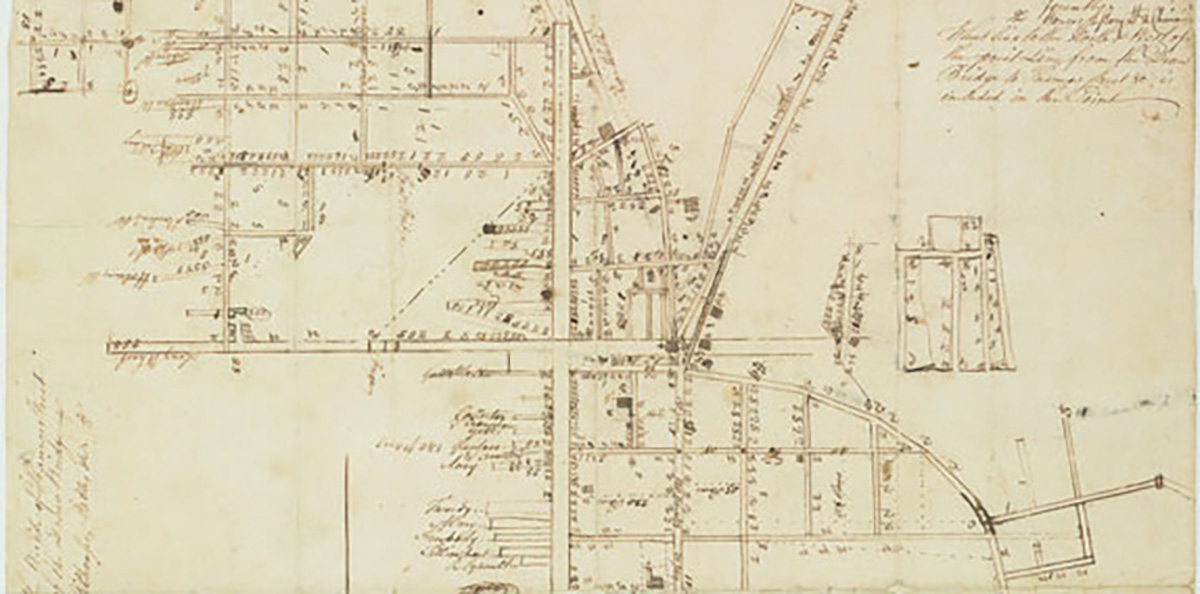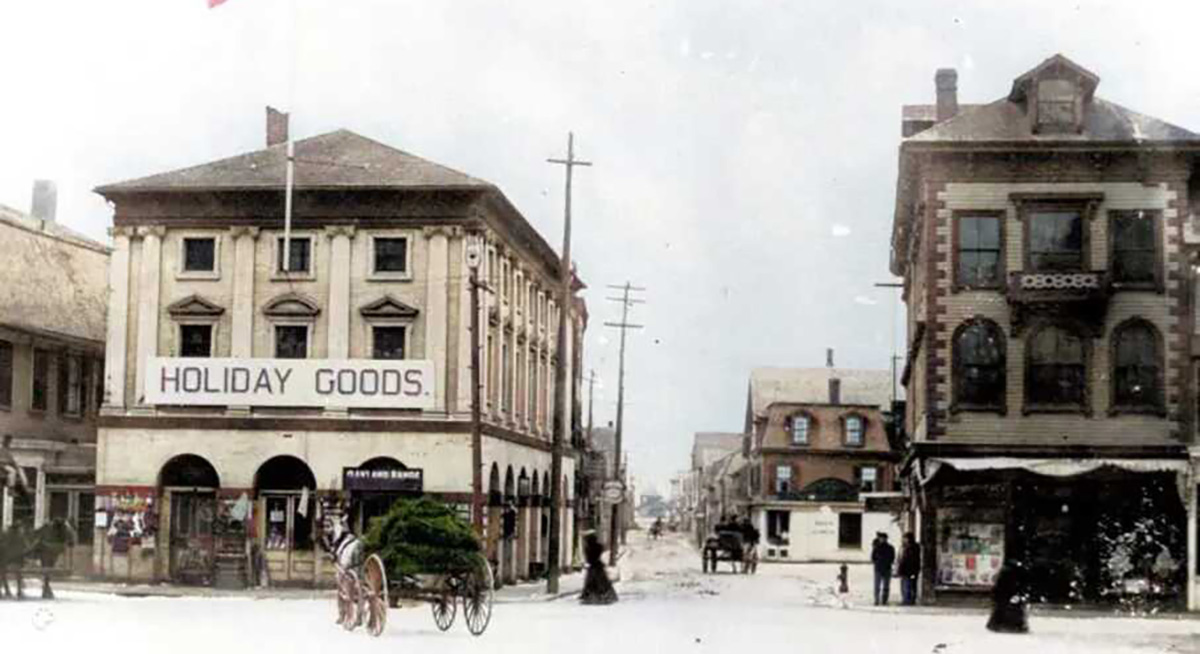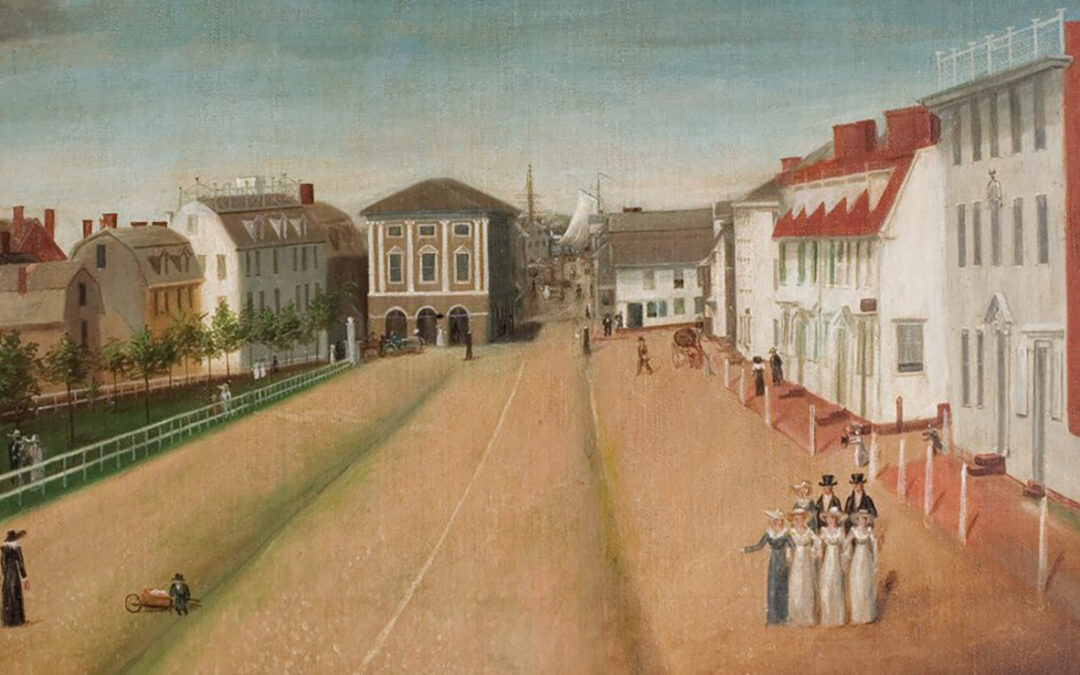Painting of Washington Square and Long Wharf – 1818
One of Newport, Rhode Island’s oldest and most important landmarks is not a building, but a road called “Long Wharf.” When Newport was first founded in 1639 it was settled based on two critical characteristics: a well-protected harbor just off the Atlantic Ocean; and a freshwater spring located just inland. Around the spring grew up the town green, which was originally called Queen Anne Square, but was renamed Washington Square to honor the United States’ first president upon his passing in 1799.
From this location a long dock was built out into the Narragansett Bay off to a rocky point of land. This dock became known as Long Wharf and formed the central east-west axis of the Newport Settlement. Built along the waterfront was Thames Street, the primary North-South thoroughfare in the city. The central role of these two streets is evident in Ezra Stiles’ hand drawn map of Newport from 1758.

Ezra Stiles Map of Newport – 1758
The wharf was primarily used for the loading and unloading of goods such as lumber, tobacco, rum, and molasses. The Long Wharf was also an important center of shipbuilding, with shipyards located nearby. As Newport’s economy grew, so did the Long Wharf. In the late 1700s, the wharf was expanded to accommodate larger ships.
In 1741 the “Old Colony House,” which is the second oldest extant colony buildings in America, was designed by Richard Munday to face due west directly down the hill on axis with Long Wharf. This building was the civic center of Newport, and Rhode Island, until the current statehouse was opened in Providence in 1901.
The Brick Market was constructed at the intersection of Thames and Long Wharf in 1763. This building was designed by Peter Harrison, a noted Colonial-era architect. The building, which was the commercial center of Newport, is now considered to be one of the most important American Colonial Era masterworks. Although the structure has gone through many forms and functions over the centuries, it has fortunately been largely preserved and restored, and has stood adjacent to Washington Square and Long Wharf as a recognizable landmark since its completion.

Long Wharf – 1885
In 1776 Newport was the fifth most populated city in the American Colonies, largely due to the trade that was made possible by exceptional religious freedom that existed in Newport. This made Newport a welcome base for talented Quaker furniture craftsman like the Townsends and Goddards, and for Jewish Merchants like Aaron Lopez and Jacob Rodriguez Rivera. Unfortunately, the very characteristics that made Newport a thriving colony also made it an ideal base of operation and the city was taken over by the British in December of 1776 and held until October of 1779, when the British were pushed out by the French Naval force under command of Le Compte de Rochambeau and Admiral de Ternay. During that time, more than half of the inhabitants of the city fled and many houses were destroyed, and it would take forty years for the city to return to its pre-war population. When General Washington arrived by ship in Newport to meet General Rochambeau at the Old Colony House to parlay about how to dislodge the British from North America he disembarked and marched along Long Wharf. The march of the combined French and American forces was first assembled in Washington Square, which is where the Washington-Rochambeau Revolution Route (W3R) begins. Various landmarks indicate the 680-mile trail leading from Newport to Yorktown Virginia where the final victory occurred.
After the completion of the Revolution, Newport took a long time to return to prosperity, but the Long Wharf was still an important site for immigration, with thousands of people arriving in Newport by boat and disembarking there over the years. During the 19th and early 20th centuries, the Long Wharf remained an important center of commerce and industry, but as the shipping industry began to decline, the wharf began to fall into decline. By the mid-20th century, the Long Wharf was in danger of falling into disrepair.

Brick Market – 1885
In 1968 the Pell Bridge was completed, connecting Aquidneck Island and Newport with Conanicut Island to the west. This new four-lane bridge was connected to the center of Newport with a new four-lane road called America’s Cup Boulevard. Sadly, this automotive focused roadway caused the demolition or relocation of entire neighborhoods of Colonial Era buildings and had the effect of cutting off the traditional waterfront wharves and businesses from the historic residential communities, essentially cutting Newport in half.
The Long Wharf, in a fit of urban clearance design miscalculation, was turned into a pedestrian shopping mall and planted with trees and planters, thereby blocking the view and natural passage from Washington Square to the waterfront. Like many other pedestrian shopping centers, particularly in cold climates, the business failed to get the traffic necessary to thrive and there was significant turnover of businesses in the center as each one struggled to survive before failing or moving to a more active retail location.
In 2006 and in 2017 A4 Architecture was invited to remodel the two 1960s urban clearance projects to give them a more historic and vernacular character. Additionally, the deteriorated concrete planters and trees blocking the connection between the Colony House and the waterfront were removed with the city’s permission. However, in the middle of winter or after 5 pm the Long Wharf center still suffered from a lack of multi-modal traffic, including cars, bicycles, wheel chairs and pedestrians. Now a proposal has come before the Newport City Council to revitalize the Long Wharf area by restoring the traditional character to the street as it benefited from the founding of Newport until the closing of the street in 1968. This is the chance for the city to move forward by studying its historic roots and restoring those traditional relationships to what they once were in one of the most historic cities in America.
Ross Cann, RA, AIA, LEED AP, is an author, historian, and practicing architect living and working in Newport, RI. He holds degrees with honor in Architecture from Yale, Cambridge, and Columbia Universities.
At A4 Architecture + Planning we are expert at integrating “Green Complete Streets” principles into our urban designs to provide safer and more long-lasting building solutions for our clients. If you are interested in learning more about what we can do for you reach out to us at any time.

Long Wharf and the Newport Yacht Club?
As I understand it, the original NYYC land base in Newport when it was founded in 1844 was a modest building located at the site of the Moorings restaurant. In 1988 the club purchased the Harbour Court mansion from the Brown family, and that has become their Newport clubhouse since that date. Their New York clubhouse on 44th Street opened in 1901 and continues to be their home base although I suspect their facilities in Newport are now considerably larger.
Great info. Was stationed in Newport until 1971. Come back every year.Have seen lots of changes, most, not so good. Interested in the Spring redo.
Seeing the wharf area of Newport reimagined and reconnected to Washington Square would be a wonderful thing if realized. I have often thought the newer retail area looked to be transplanted and never belonged. It’s a shame the roadway bisects the waterfront and retail/restaurants, disconnecting one from the other. Great article!
We agree that Long Wharf has tremendous potential if restored to its historic condition.
Nice article. I’ve never been to Newport, but my cousin’s daughter got married there last May.